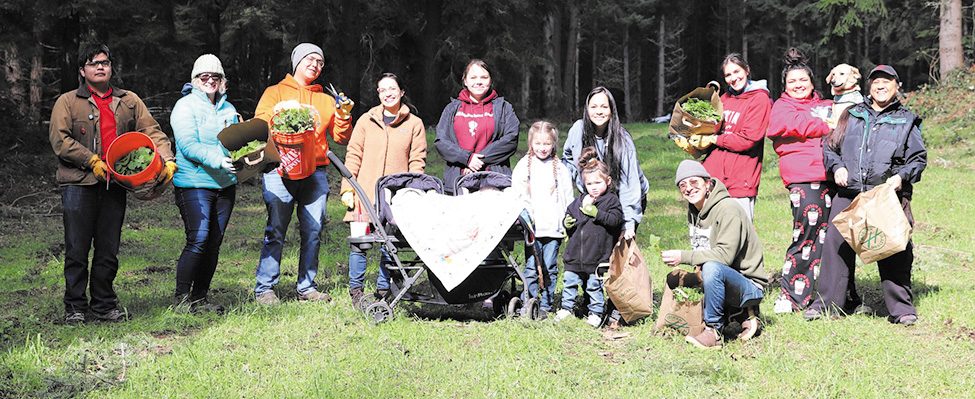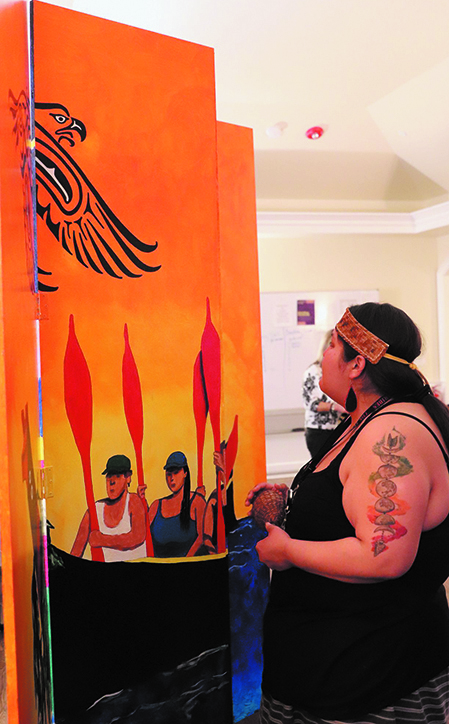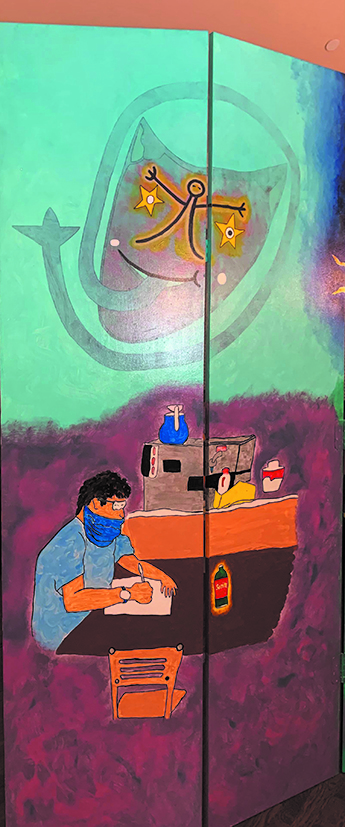Please follow the following link to the March 26, 2022 issue of the syəcəb
Beyond Surviving to Thriving
Tulalip Problem Gambling program and Tulalip Healing Lodge residents unveil new mural
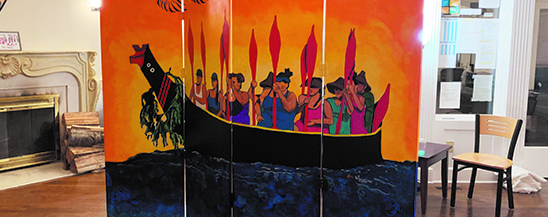
By Kalvin Valdillez, Tulalip News
“This was an amazing experience because recovery is a journey, and it doesn’t always have to be about going to treatment,” said Tulalip Problem Gambling Counselor Robin Johnson. “This was a work in progress and people really put their hearts into this project.”
Last spring, the Tulalip Problem Gambling program hosted an art therapy class for the residents of the Tulalip Healing Lodge in hopes of bringing a fun and creative form of healing to those in recovery. The Problem Gambling program enlisted Tulalip artist Monie Ordonia to lead the class. Feeding off her good vibes and energy, the participants took a strong liking to her teachings and fully engaged in the art therapy class. During that session, Monie asked the Healing Lodge residents to create from the soul rather than the mind, and that work would eventually become the main fixtures on a living and traveling 7-foot four-panel mural.
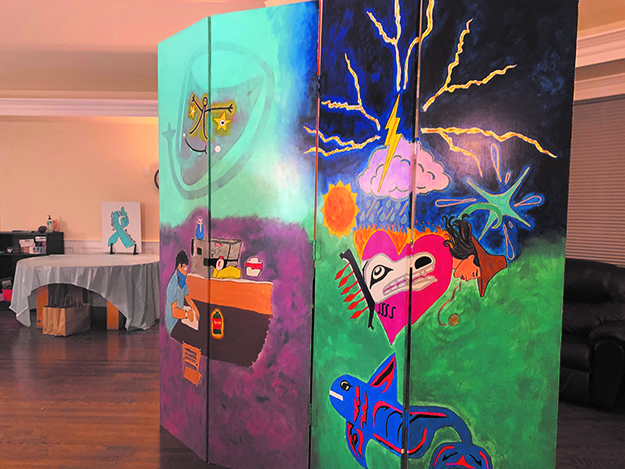
“I’m so happy we picked the right person to do the project with everybody. Everyone that knows Monie, knows that her heart is 100% pure and that her spirit is 100% in everything she does. She loves her community, she loves people. I’m really happy this came together the way it did,” shared Problem Gambling Counselor, Sarah Sense Wilson. “It went from us sharing Problem Gambling information with the residents and right into conceptualizing what they were going to create, with the theme that this is about healing, surviving and thriving.”
First established in 2015, the Healing Lodge has helped both Tulalip tribal members and those enrolled with other tribal nations attain and maintain a healthy and sober lifestyle. By providing a safe space to reside, away from bad habits and negative influence, the Healing Lodge also offers their residents group therapy and activities, giving their participants the opportunity to build community with others who are striving for the same goal. And, likewise, the Problem Gambling program has become an important resource to the Tulalip community, helping those battling a gambling addiction find their way out of the dangerous cycle byway of an intensive plan to recovery.
The first group of Healing Lodge residents showed such a great amount of interest in the class, the Tulalip Problem Gambling program decided to take it to the next level and asked Monie to lead the residents in the mural project. Monie took the original artwork created by the residents, from the first art therapy class, and transferred them to one side of the four-panel mural. That side of the mural consists of a shark-whale in traditional formline, a star-eyed mask, a portrait of one of the residents, and a Salish woman wearing a cedar-woven hat. The opposite side of the mural features a Tulalip Canoe family coming ashore, with their paddles up, as an eagle soars high above them on the Salish Sea.
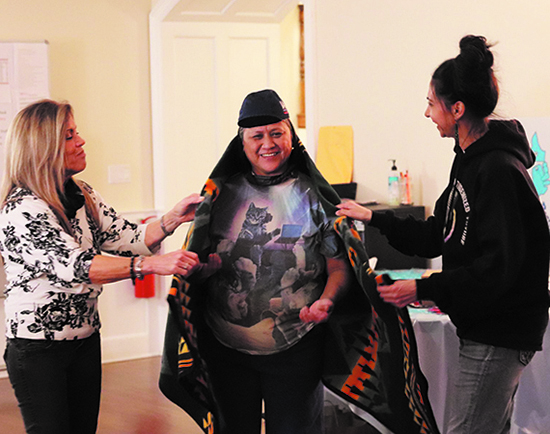
Said Monie, “I was really honored to be asked to be a part of the Healing Lodge. I truly believe that we all have the capacity to go beyond our hurt. For this project, the question I asked the residents is, are you surviving? And we know, from our ancestors, we already survived. So, when you think about what’s the next stage after surviving – it’s thriving.”
She continued, “When we came up with the concept, I asked what does thriving look like now that you discovered that you can be a part of the medicine that brings you beyond your addictions? A lot of the members who were here began drawing what that medicine meant to them. I followed through and one of the hugest medicines we have for the Tribe is pulling canoe. Being someone who didn’t grow up on the reservation, to be able to become part of the Tulalip Canoe Family, I knew from experience how magical and mystical it is to pull canoe. To be on the water with fellow tribal members means to be a team, to help each other pull through the water. As we are singing our songs, those are the prayers – and our ancestors are on the water reflecting those prayers and songs back to us. That’s why we made this side so significant. That medicine, if you ever been on the water, you can feel that energy.”
Throughout the past year, Monie traveled north to the Healing Lodge to work on the project with the residents. And although the artwork itself is a form of medicine, the time and energy put into the work was just as much of a healing experience and strong medicine to those working on their recovery journey. During the painting sessions, the artists conversed with one another, got to know each other better, shared laughter and even some dance moves while Monie played music from her DJ sets over a portable speaker.
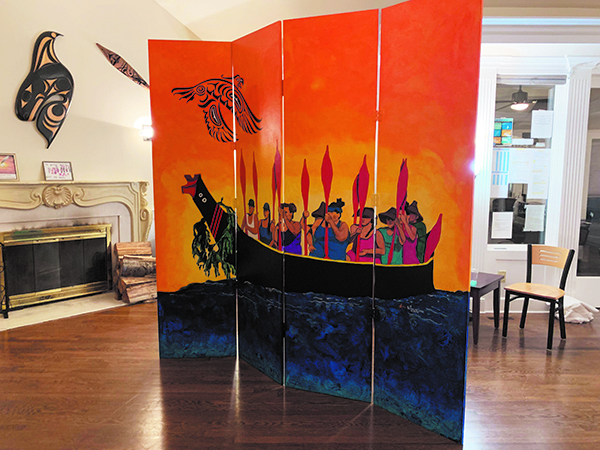
Multiple studies show that art therapy assists greatly in addiction recovery, boosting self-esteem and reducing anxiety and stress levels, while also allowing the artist the space to go inward and address and resolve any personal conflicts they may be facing. The amount of time that each resident spends at the Healing Lodge varies as each person’s journey to recovery is unique. That means that since the project originally started, several residents have come and gone throughout the months. Therefore, many recovering addicts had a hand in creating the mural and experienced all the benefits art therapy has to offer first-hand.
One resident, Justine Moses, was involved in the project from start to finish. She shared, “I worked on three areas on the mural: the lady, the whale and the canoe. It makes me feel pretty good, confident and content, about my culture. I’m just happy to be here and glad to be a part of the project. It was healing for me, just putting my mind to it and sitting down and working on it. Monie is a good woman, and it feels pretty good to see it complete. The revealing was my favorite part, showing everybody the beautiful art piece that we all made together as a team.”
The unveiling of the mural was a special and intimate gathering on the eve of March 18, as Monie, the current Healing Lodge residents, the Problem Gambling program and the Healing Lodge staff members came together to bless the mural and view the completed project for the very first time. Many were moved to tears, in awe of the medicine that went into the project and the beauty that resulted from the healing art sessions.
“The month of March is National Problem Gambling Awareness month and so we felt it was really fitting that all of this came together just in time. For a month that is about healing, growth, change, self-discovery and moving forward,” Sarah expressed. “This unveiling ceremony has been a long time coming, we spent nearly a year on this project.”
Now that the project is complete, the Problem Gambling program and the Healing Lodge plan on displaying the mural throughout the reservation so others can see the positive and inspiring work that served as medicine to many while on their road to recovery. The first stop for the traveling mural will be at Problem Gambling’s Reclaiming Our Connections dinner event, happening at the Tulalip Resort Casino on the evening of March 26th, in honor of National Problem Gambling Awareness month.
“This is the Healing Lodge’s message to future generations on how residents who come here have thrived through their voice and art,” said Monie. “To be a part of this, whatever part you have contributed, know that this is your medicine that your grandchildren will see in the future – beyond surviving to thriving.”
For more information about the Tulalip Problem Gambling program, please contact (360) 716-4304. And to learn more about the Tulalip Healing Lodge, please visit https://www.tulaliphealthsystem.com/BehavioralHealth/HealingLodge.
NARCAN distributions ‘about saving lives’
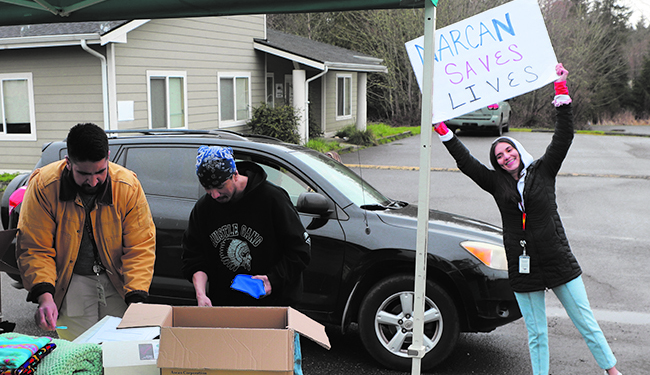
By Micheal Rios, Tulalip News
Since its formation in late 2020, the dedicated staff of Tulalip’s Overdose Detection Mapping & Application Program (ODMAP) has been hard at work tracking and monitoring overdoses on the reservation. They are focused on promoting a healthy community and providing outreach work through accessible resources for those hit hardest by the opioid crisis.
Through their overdose mapping technology, it’s evident that the Mission Highlands and Silver Village housing projects are the leading overdose hotspots on the reservation. With this invaluable information in mind, the ODMAP team held potential lifesaving NARCAN distributions in both neighborhoods. NARCAN is a fast-acting drug used to temporarily reverse the effects of opioid overdoses. It can prevent death if administered quickly.
“NARCAN saves lives,” said Tashena Hill, ODMAP outreach specialist. “Until we can connect a person suffering from opioid use to treatment, we will wok with individuals, loved ones and concerned members of the community to make sure they are prepared to respond if an overdose does occur. We urge anyone who needs access to NARCAN to attend one of our distributions or, better yet, reach out to us directly so we can review the signs and symptoms of an overdose and how to easily administer NARCAN. The mission of our department, including these free to the public distributions, is all about saving lives.”

How to save lives is a prevailing mission behind so many local, state and federal health departments as the nation comes to grips with yet another pandemic. This one is opioid-based and being super charged by a steady surge in fentanyl-laced street drugs.
According to provisional CDC data released March 16, an estimated 105,752 Americans died from overdoses in the 12-month span ending October 2021 – the highest number of overdose deaths recorded in the United States in a single 12-month period. Bringing the scope more local, Snohomish County logged 232 deaths from overdoses in 2020, which is also the most in recorded history. And if focused solely on the Tulalip membership, the scope reveals there have been at least 16 overdose deaths since the start of 2020.
It is with these sobering statistics in mind that programs like Tulalip’s ODMAP are prioritizing making lifesaving resources assessible and bringing them directly to where they are needed most. By going directly into the neighborhoods at most risk of producing more overdoses, the ODMAP team and their NARCAN distributions are impossible to miss, with their drive-thru like setup and rallying signs to nab the attention of passers-by.
Their Mission Highlands distribution was held on Valentine’s Day, when twenty-five NARCAN kits were given away. Silver Village’s distribution took place on March 17, St. Patrick’s Day, and was even more successful as thirty-plus NARCAN kits were given out.
“We’re bringing the resources to the people,” said ODMAP project coordinator, Kali Joseph. Armed with her upbeat attitude and ‘NARCAN SAVES LIVES’ sign, she corralled several vehicles as they entered the Silver Village main entrance where they were then greeted by Tashena or Jackson Nahpi. Together they reviewed everything in the Tulalip Pharmacy Narcan Kit and answered any questions that were asked.
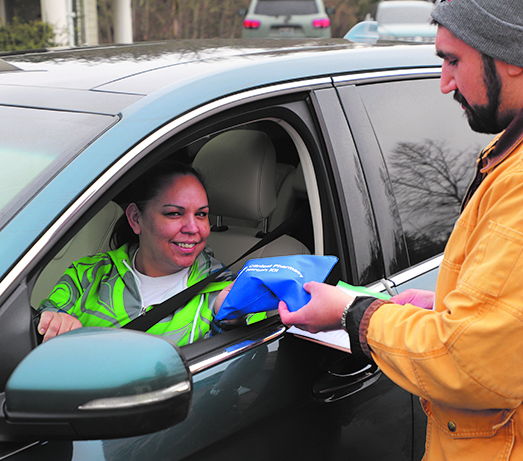
“For the simple fact that NARCAN can save lives, it’s worth having in every Tulalip household. It just furthers the conversation and makes it not a taboo subject. I carry one on myself in any situation, just to have it accessible in case I’m a bystander and it’s needed…because you never know,” shared Kali.
“It’s so important that as a community we destigmatize substance use disorder (SUD) because often times its mistaken as a moral failing or personal choice,” she added. “As Native people, we are overrepresented in SUD and overdoses and things like depression and suicide. A lot of the SUD may stem from impact of intergenerational and historical trauma. There’s a lot of social factors at play as well.”
Normalizing NARCAN and viewing it like an inhaler or EpiPen that can be used as an antidote to revive people from the brink of death is an effortless way of practicing effective harm prevention. NARCAN is a nasal spray. It looks like a common antihistamine and is administered by squirting directly into the nose. It is not dangerous to the person administering it, and it will not hurt anyone who doesn’t have opioids in their system. Plus, anyone administering NARCAN is protected by the Good Samaritan law.
The degree of disclosure at both of ODMAP’s neighborhood NARCAN distributions was perspective altering. Several citizens shared with members of the ODMAP team their experiences, both personal and as witnesses, with opioid overdose and how NARCAN saved the day. One young lady shared she keeps NARCAN at the ready because her mother is a heroin user and fears she’ll find her overdosing one day. Another young man disclosed his partner overdosed in the past and if it weren’t for NARCAN, she probably wouldn’t have made it.
While future distributions are in the works, ODMAP is also considering going door to door in order to reach their goal of having a NARCAN kit in each Tulalip household. In the meantime, if you’re a Tulalip community member and would like to receive a free NARCAN kit please call or text 360-722-2255 or visit www.tulaliptribalcourt-nsn.gov/ProgramsAndServices/ODMAP
Walking through my story part 3:
Tulalip Problem Gambling program participants shares recovery journey during awareness month
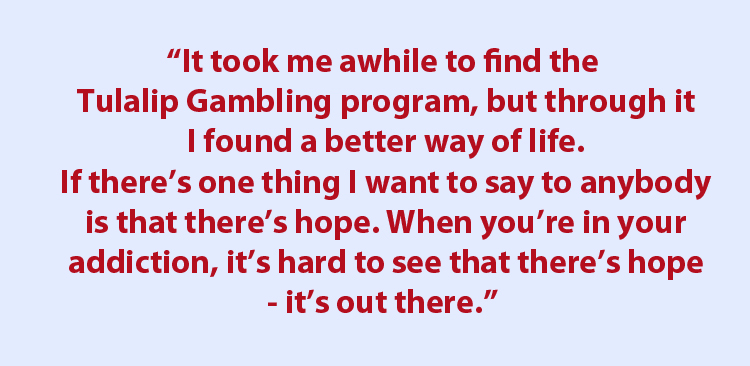
By Kalvin Valdillez, Tulalip News
“It’s an escape. It’s a high for sure. It’s a risk. I thrived for that high,” recalled recovering gambling addict, Walker. “It wasn’t the win; it was the anticipation of the win. What made it the most destructive addiction I ever known was that I could show up like a regular person and just sit down and all I had to do to make it happen was put money into a machine. It’s such an acceptable thing, but it’s so dangerously addicting. And once people are addicted, it’s really hard to tell that they are. There are so many ways to feed it. You can sell your stuff, you can cash out your 401k, you can get payday loans, you can do all these things in the hope of getting that next high, but because you’re addicted, it’s never enough. Like any addiction, you destroy yourself to feed it.”
An estimated two million American citizens meet the criteria for severe gambling addiction any given year, according to the National Council on Problem Gambling. Although that is only one percent of the entire population, that is still a lot of people who are more-than-likely quietly battling this dangerous disease as well as the many problems that occur as a result of the addiction.
Walker expressed, “Nobody knew I had a gambling problem. I’d have to make up all these excuses like why my cell phone got shut off. I’d tell all these lies with a smile on my face. I couldn’t control myself. I sold everything I could sell. I just didn’t have anything left and I couldn’t stop. There was no way out. But I maintained my job, I would put myself through all this turmoil and then I would go to work and pretend like everything was okay. There were people who loved me, but they didn’t know I needed help.”
Native Americans are at the highest risk of developing a gambling habit. If you have been following our coverage of National Problem Gambling Awareness month, you may be familiar with the following and shocking statistic. A 2019 study conducted by the National Institute on Alcohol and Related Conditions showed that 2.3% of the entire Indigenous population are fighting a gambling addiction, the highest percentage in the nation. Unfortunately, this three-year old study is the most current research, but after three-years of dealing with the global pandemic, that percentage is expected to be on the rise.
“I’ve had other substance abuse issues in my life,” Walker said. “In my youth I had trouble with marijuana, and in my adulthood, I had trouble with alcohol. I was into drinking pretty heavy, I already started some isolation in my life, I was single at the time. And I just started gambling. It started out pretty innocent, and it just progressed. What was interesting for me, as it progressed, my need for alcohol kind of fell away and gambling took hold. I got to a point where I was still drinking, but gambling became my main addiction. I wouldn’t drink when I gambled, and the insanity of it is, I looked at it as a benefit, as a positive early on.”
He continued, “I was gambling during the week, and it was just so progressive in my life. I went from gambling afterwork to where my weekend routine was getting up, throwing on my clothes and going out to gamble. I would get paid on Friday and I would go to the casino. I would either devastate myself with my losses or I would win. No matter which the case was, I couldn’t wait to get back there on Saturday morning. And my Saturday mornings were spent either trying to keep the high or get back my losses. When I would gamble, it was a reckless cycle. I was going to gamble until it was gone, and I was going to suffer until I could go back again.”
Throughout the month of March, the Tulalip Problem Gambling program takes part in a nationwide initiative known as National Problem Gambling Awareness month and hosts several events and gatherings in the Tulalip community. Originally, the campaign began nearly twenty years ago in response to the amount of sports gambling surrounding the NCAA March Madness college basketball tournament.
During awareness month, the Problem Gambling program and Tulalip News teamed up to share a series of stories of individuals who utilized and benefited from the program during their recovery journey. Walker is the third individual to share his story about how the Tulalip Family Services Problem Gambling program helped save his life through their intensive outpatient recovery care.
“I first heard about the Tulalip Problem Gambling program, I was just a little bit less than a year in recovery, I had 11 months clean time,” Walker reflected. “A friend of mine was in the program and she told me about her experience with it. I hadn’t heard of it and my background before that was only GA (Gambler’s Anonymous). So, I went into Tulalip Family Services and took an assessment, and I honestly didn’t think they would take me because I had clean time. My perception was that it was for somebody who was just beginning to get help with their addiction. I did my assessment with Robin and was admitted to the intensive outpatient program. That’s where my recovery really took on a bigger meaning for me, I can’t tell you enough my joy in the fact that I began to work on myself. I began to look at my past, my childhood and young adult life, and identified some of the triggers that led me to addictive behavior.
Right away when I walked through the door, there was an expectation of accountability – that was really big for me. And the homework. We would do in-class assignments but the real tough one for me, that really challenged me, is I had to write a timeline of all my major life events and along that timeline, write-in my addictive cycles. I was able to see that maybe I had some trauma in my life and that would result as the beginning of an addictive cycle.”
The Problem Gambling Program, led by counselors Sarah Sense-Wilson and Robin Johnson, provides a plan to recovery tailored to each individual’s needs while incorporating tribal culture, and a number of fun events and activities throughout the year. Several Problem Gambling participants have experienced a great deal of progress as they worked through the program, alongside individuals who are on a similar journey. Due to all the success stories that are a result of the Tulalip Problem Gambling program, many local tribes are now following their model and building programs on their own reservations to help their membership and fellow community members.
“Sarah was my counselor and one tool that she taught me was just to weigh everything out,” he shared. “It was how to deal with issues, how to deal with the problems in your life. For me, the main tools I walked away with were how to cope with life, how to avoid triggers, how to deal with triggers, and thinking things through before you encounter them.
There was that, and there was also an exercise that is called ‘Our First Step’, which is a no-excuses, no-reasoning account of our addiction. And what that means is that you don’t put down that you behaved a certain way because…. – you leave out the ‘because’. You just write down what you did. If you committed a crime, you write down you committed that crime. You don’t write down that it was because where you were at in that particular moment of your life, just the facts. It was really stunning – I’m going to come to tears a little bit – it was really stunning to read that back to myself. You don’t want to return to something when you look at it straight in the face and you quit rationalizing it.”
As you can gather, the Tulalip Problem Gambling program has been a reliable source to those attempting to put an end to their gambling addiction, helping those in recovery along their healing journey. Since its establishment, the program has served not only members of the Tulalip tribal community, but non-Natives, who are fighting a gambling addiction and live in our neighboring communities as well.
Said Walker, “I was in the program for a solid two years. I did finish the program, but I am still in contact with them. My life is nothing like it was before. I was in complete devastation. I lost everything. I had nowhere else to turn. I feel it was the grace of God that gave me recovery, and led me from GA to the Tulalip Problem Gambling program to where I am at today. It’s a completely different life. I am married today, I couldn’t even visualize for myself having a relationship, much less a marriage. And here I am, married to my wife who knows about my addiction. One of the things that recovery at the Tulalip Problem Gambling program taught was don’t keep secrets because secrets just give you an excuse not to work on yourself, not to face it. There’s real power in walking through a door when you are so screwed – there is nobody to understand you – that’s what you believe in your head. But, when you walk into Tulalip Problem Gambling program, there’s people who been there and understand and want to stand with you. That’s where you can have a fresh start.
You can’t do it on your own when you’re hurting, you’ll resort back to what you believe is going to fix you, which is your addiction. For me, I always felt that I could fix it with another win. The GA programs are really great, but they don’t allow you to talk about other opportunities during an active meeting. I think a lot of people who hear about the Tulalip Problem Gambling program they [assume] that it’s sponsored by tribal funds from the casinos, and they think it’s not good. But it is so the opposite. I encourage those who need that extra help to give themselves a chance, to work on themselves, to recognize that other recovery programs are great for support, but intensive outpatient treatment is what we need because we need to get better, so we don’t return to our addictions.”
The Tulalip Problem Gambling Program is hosting events throughout Problem Gambling Awareness Month, leading up to an in-person dinner event taking place at Tulalip Resort Casino on March 26 at 6:00 p.m.
If you or someone you love is dealing with a gambling addiction, or if you would like to find out more information about Problem Gambling Awareness month, please contact (360) 716-4304
*The following is a more in-depth look at Walker’s journey to recovery in his own words, which were shared and recalled upon through tears and heartbreak. Trigger warning – Walker speaks about serious issues including contemplating suicide.*
It was November of 2017; it was the first time I couldn’t pay my rent and that was a real shock to me. Basically, I fantasized about playing with my whole paycheck before I would even get it. I gambled heavily but I wanted to gamble even more, so I did just that. It had various outcomes and it caught up to me when I couldn’t pay my rent. I thought I was going to be evicted because I never been in that situation before.
I went to my landlord and to my parents and told them I had a gambling problem. That was my first step towards recovery, but it wasn’t true. It was false because that was it – that’s all I did, tell them. I got a stay on my rent and got caught up, but by December I was back in the casinos. It went from December, January and February, those three months my addiction took off. I couldn’t keep a paycheck for all those months.
It got so bad that I couldn’t eat. I didn’t have food on the table. My house was falling all around me. I isolated myself from my friends, family and kids. I wouldn’t let anybody in my house. I couldn’t take care of my dog. Some of my worst memories are using my free play to get a burger and tater tots and bringing it home to split it with my dog. And going to Fred Meyer with change and putting in the [Coinstar] machine so I could buy a bag of potatoes.
One weekend I went out and did it to myself again and I just lost it. I couldn’t do it again; I was completely out of steam, so I was making plans to take my life. As I was in my bedroom preparing to do just that, I thought to call my parents. I needed to be bailed out and they were able to come through for me by a miracle. That was it for me. That was my reset. I’m so grateful for that. I had to hit a really hard bottom in order to reset.
I was always in a pattern of trying to get back and I was always doing the things that come when you’re addicted to gambling. I was selling my stuff, I was pawning my stuff and trying to get it back out of pawn, I was engaging in high-risk loans. I developed rituals and would only go to one casino, I felt that was the place where I could be successful – it was the Quil Ceda Creek casino and sometimes I would go to the big casino if I was ahead. I didn’t really go to other casinos in the area. I was physically addicted, later when I was trying to find recovery, I slipped a couple times. Finally, I banned myself and that really helped.
Banning myself from the casinos was huge for me because after I hit bottom, I turned all my finances over to family and I still wasn’t in any recovery program, I just separated myself from cash. My parents would give me forty or sixty bucks and I would just battle – I would drive circles in Everett not knowing what to do. I had a social worker assigned to me because I was going to take my life. I told her one day, “when I’m done, I’m planning to go to the casino”, and she told me that I needed to go to a meeting. That’s when I found GA and later found the Tulalip Problem Gambling program.
GA is nationwide and they have a website where you can find active meetings and you just show up. But the difference for me, between GA and the Tulalip Problem Gambling program, is with GA you show up and there’s support for you, but you have to find the help yourself. Where with the Tulalip Problem Gambling program, I walked through the door, and they helped find the help I needed. They are professionals and there’s accountability, that GA doesn’t offer.
It took me awhile to find the Tulalip Problem Gambling program, but through it I found a better way of life. If there’s one thing I want to say to anybody is that there’s hope. When you’re in your addiction, it’s hard to see that there’s hope – it’s out there. That’s the great thing about the program, Sarah and Robin facilitate a lot of hope through the Tulalip Problem Gambling program.
March 19, 2022 issue of the syəcəb
Please follow the following link to the March 19, 2022 issue of the syəcəb
Tulalip hosted Jr Nationals a huge success
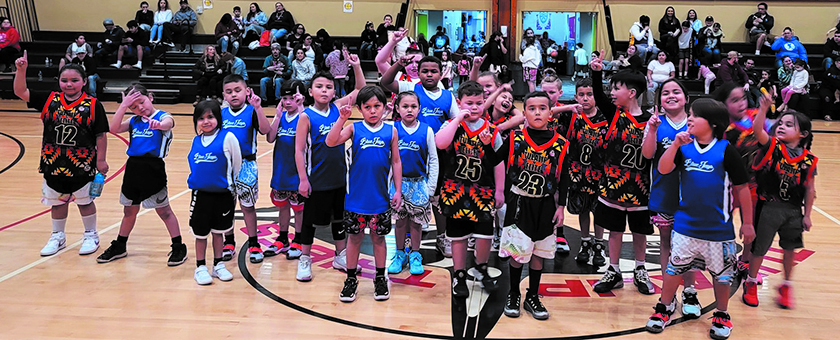
By Micheal Rios, Tulalip News
Over the three-day span of March 11–13, bucket getters from reservations all across the Pacific Northwest journeyed to Tulalip to participate in a thrilling Jr Nationals tournament. The first major basketball tournament in over two years produced stunning nail biters, wire-to-wire victories, clutch time shots, and memories galore for hundreds of Native spectators who cheered on their favorite hardwood hoopsters.
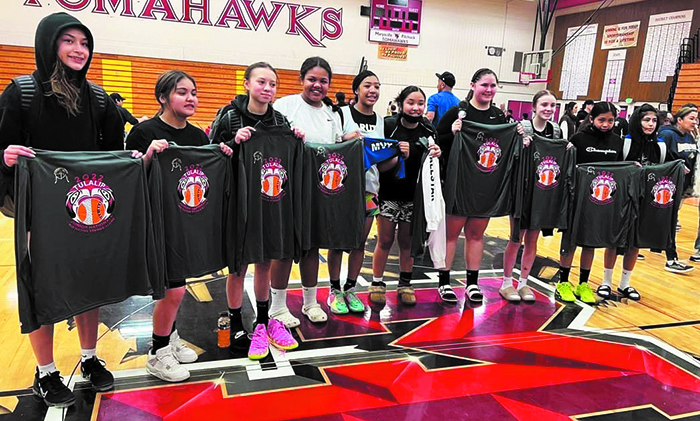
There were nearly a dozen competitive divisions, from 8U up to 18U, filled with boys, girls and co-ed teams. There were so many teams that tournament coordinators reached out to Marysville Getchell and Marysville Pilchuck high schools for access to their basketball courts. Both schools graciously offered their courts for play to give the tournament a whopping seven courts of action, including those at the Youth Center, Boys & Girls Club and Heritage.
In total, a whopping 50 teams came together to play over 100 games over the three-day tournament. Giving players and coaches countless opportunities to showcase the free flowing, fast paced brand of ‘Rez ball’ that Native hoopers are well-known for.
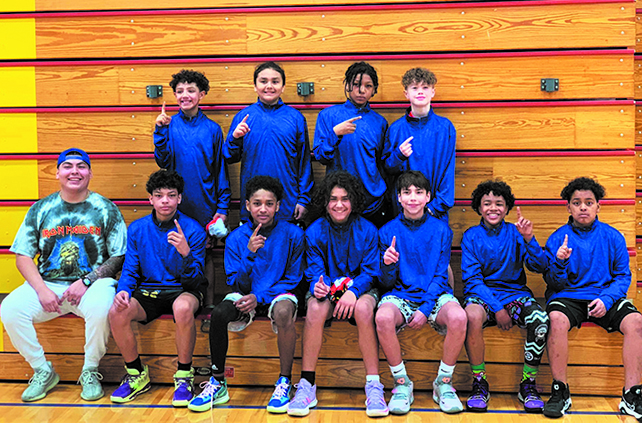
“Traditionally, Jr Nationals is one of the first youth tournaments hosted on this side of Indian Country. It kick starts the tournament trail for parents, coaches, and athletes and gives them a long awaited opportunity to showcase all their skills and hard work,” explained Youth Enrichment manager Josh Fryberg. “It’s a great time for us as adults and coaches, too, because we’re able to network and see how we can continue to work together to make our youth and communities better.”
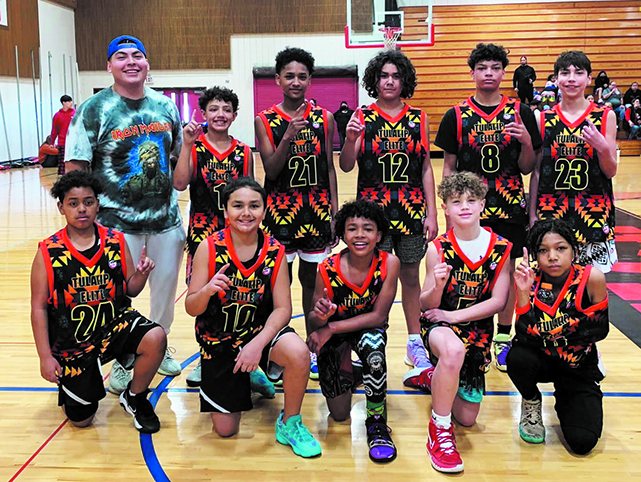
A horde of local Tulalip talent was present throughout the multiple divisions and age brackets, where they tested their dribbling and jump shot making skills against determined defenders from Muckleshoot, Lummi, Neah Bay, Yakama, and Lapwai.
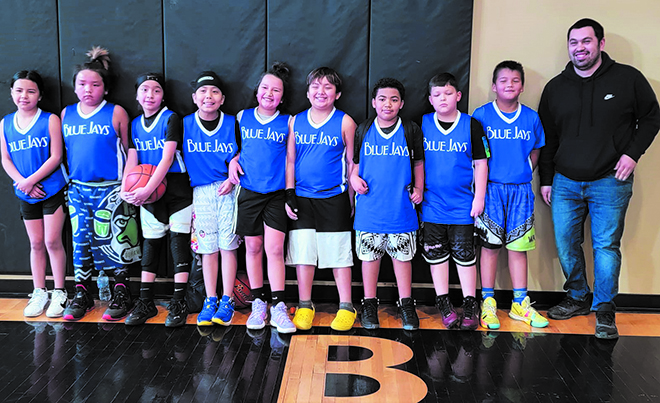
“It was really good to see all the athletes and coaches on the court again, along with all families that travelled a long way so their athletes could participate,” said Josh. “There was a lot of great competition and even more laughs and smiled shared. The entire tournament went really well and we are pleased with the level of engagement we received from tribes both near and far.”
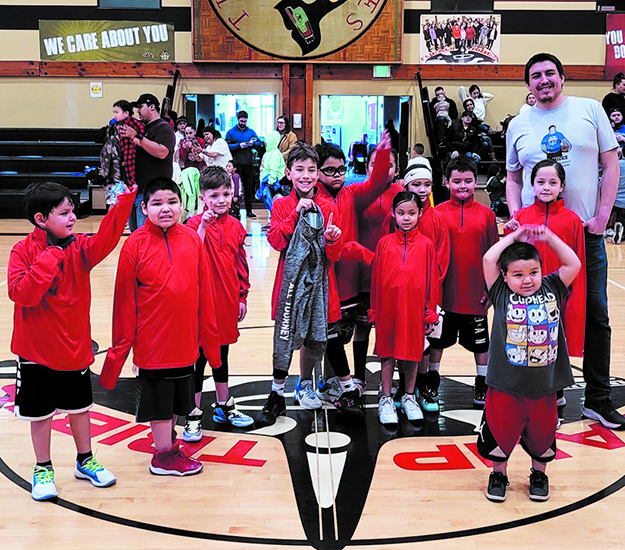
Among the many proud parents and guardians cheering loudly from the sidelines as their kids dribbled, passed, and put up jumpers to their hearts content was momma bear Sarah Murphy. Four of her sons competed in Tulalip’s Jr Nationals tournament; Gaylan in 16U, Jaylan in 12U, Josiah in 10U, and Zaedyn in 8U.
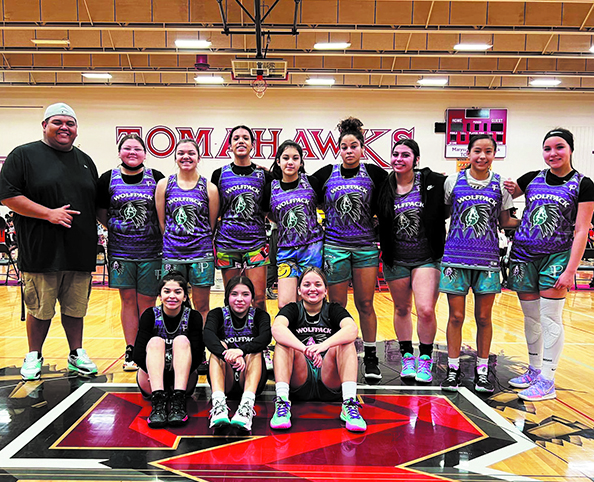
“It was amazing to see my boys out on their home courts again, playing for Tulalip teams and having so many local tribal members root for them to be successful,” reflected Sarah. “Normally, its our oldest son Gaylan bringing home the championship hardware, but not this time. His little brothers have been watching and learning and this tournament all their hard work paid off. Zaedyn had so much fun playing with the 8U team and taking 2nd place. Meanwhile J.J. brought the ship home for the 12U boys.
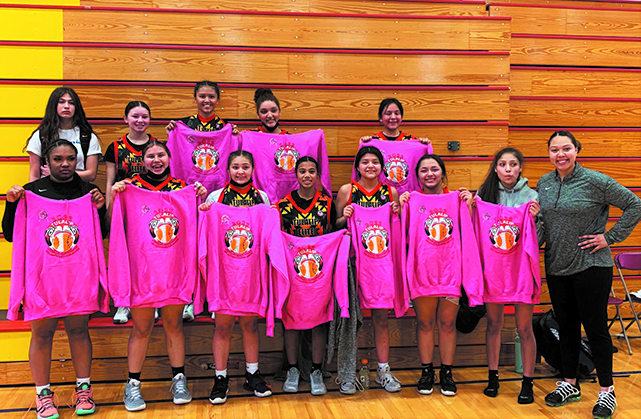
“Our car ride home after the tournament finished was definitely memorable because J.J. kept saying ‘It’s my time!’” she added. “As a mom with boys who dream of playing in the NFL and NBA someday, I was so proud of their efforts and thankful for the Tribe for allowing this tournament to happen. It was refreshing to see so many Natives on our homeland, united by sports once again. My family looks forward to many more tournaments this spring and summer.”
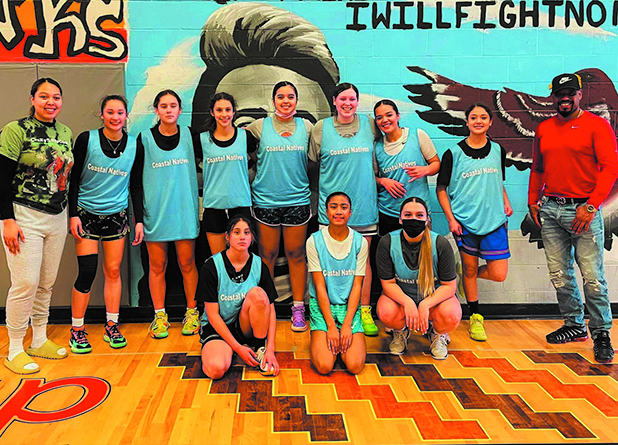
Be sure to keep a look out for flyers and accountments in future SeeYahtSub editions, or routinely check online at https://www.tulalipyouthservices.com/ for information regarding a host of basketball, softball, and other sports tournaments returning to Tulalip in the upcoming months.
March 12, 2022 syəcəb
Please follow the following link to the March 12, 2022 issue of the syəcəb
Walking through my story part II: Tulalip Problem Gambling program participants share recovery journey during awareness month
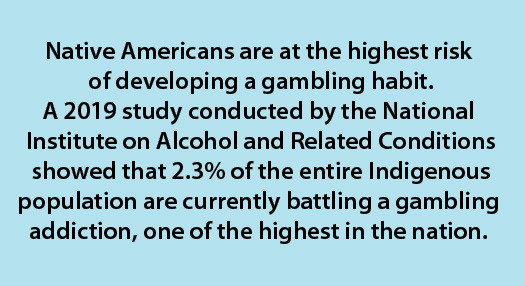
By Kalvin Valdillez, Tulalip News
As we continue our series with the Tulalip Problem Gambling program during awareness month, Tulalip News sat down with a young woman who wanted to share her story about the dangers of gambling addiction with the community. Jenny, a single parent who grew up locally, discusses the strong grip that gambling had on her life three short years ago, and how the Problem Gambling program helped her turn her life around for the better.
Over the years, the Tulalip Problem Gambling program has been a reliable source to those attempting to put an end to their gambling addiction, helping those in recovery along their healing journey. Since it’s establishment, the program has served not only members of the Tulalip tribal community, but non-Natives, who are fighting a gambling addiction and live in our neighboring communities as well.
The Problem Gambling Program provides a plan to recovery tailored to each individual’s needs while incorporating tribal culture, and a number of fun events and activities throughout the year. Several Problem Gambling participants have experienced a great deal of progress as they worked through the program, alongside individuals who are on a similar journey. Due to all the success stories that are a result of the Tulalip Problem Gambling program, many local tribes are now following their model and building programs on their own reservations to help their membership and fellow community members.
March is an important month for the program as they take part in a nationwide initiative known as Problem Gambling Awareness month. Originally, the campaign began nearly twenty years ago in response to the amount of sports gambling surrounding the NCAA March Madness college basketball tournament.
Trigger warning – Jenny talks about heavy topics in the following Q&A, including suicide contemplation.
Tulalip News: How did you find out about the Tulalip Problem Gambling program?
Jenny: Through GA (Gamblers Anonymous).
Are there a lot of people in the local GA community who have heard about the Problem Gambling program and utilize it?
I would say no, not a lot of people. The people who told me about it had been in GA for a long period of time and knew about others having success through the program.
Like you mentioned, there’s not many from the local GA community who participate in the Problem Gambling Program, but the people who are in GA that I have spoken to, the program really seemed to help them through that next phase of kicking their habit.
Yeah, it was something that I got involved in right away in my recovery. I think I heard about it during my first meeting, and then I called within the next day or two. I found that the program is phenomenal. I don’t think I would have taken my recovery as seriously without the program, and certainly wouldn’t have learned as much as I did without the program. I think that those who are in recovery, GA is a great place to be, but I believe that this program gives you a different level of recovery that everyone should have and experience.
Can you talk about your story, and how you reached that point to where you needed that extra assistance from GA and the Tulalip Problem Gambling program?
At the time I was a single mom. I had always worked really hard – just providing for my son. I’m a registered nurse and I’ve always held down and worked a full-time job; it is kind of stressful at times. I lived by the casino all my life, but I never went into the casino until about seven years ago. And immediately, because it was such a positive experience my first time, it grabbed me. I walked in and spent $100 and I walked out with $950. I just was floored, like, what?! And I found in the casino a place to go and just escape from reality and from all of the stressors in my life.
I felt like I could go in there during certain times of the day and just escape – and that’s what I did. I think the worst year was when I won forty-one jackpots in one year and I didn’t have a dime to account for it. And I owed a lot of money to a lot of different places. I took out of my 401k and lost it. I pretty much hit rock bottom. I had this internal struggle that I wanted to get help, and I wanted to stop, but I couldn’t. And I didn’t know how to.
I didn’t know what GA looked like. I didn’t know what recovery looked like. And I didn’t know if I really had a problem, but I felt like I did. I felt alone. It was through the program that I learned so much about me and about why I was gambling. That journey and discovery, was amazing. At one point, at the very end of my gambling, I felt like I needed to try GA and if it didn’t work, I already had a plan on how to take my life. And so, to get a glimpse of hope from the Problem Gambling program was phenomenal. The program gave me that everyday hope to help walk me through life on a weekly basis. Now, I am over three years in recovery!
Congratulations, and we are so happy that you’re still here with us.
Thank you. It’s all because Robin is phenomenal and Sarah’s phenomenal. I was able to bond with the girls, and even the guys, who were in my program – that definitely helped.
What were some of the tools that the program provided you with?
Oh, gosh, so many different tools. Walking through the story is a big one. Anytime I felt like I wanted to go back to gambling, basically they would tell you to kind of walk that out. Every time I went to the casino at the very end, it was destruction. Walking that out helped me. They told you to make a list of things to do if you get bored. And if you wanted to go to the casino, to ban yourself, so I did. That was a huge tool for me to go around and ban myself from all the different casinos. Building my self-confidence up and learning that gambling is an addiction that doesn’t discriminate and it’s not who I am.
You mentioned creating bonds with others in the program. I know they hold events throughout the year, were you able to take part in any of those?
I have gone to the yearly problem gambling dinner that they have every March. And I have taken some recovery coaching classes to become a recovery coach so in the future I could help others who might be struggling and needing some help.
Why were those bonds important to create?
Just additional lifelines out there. They’re there if you’re struggling, you can call them and they know what you’re going through, and they can walk you through it. It holds you accountable. If they see that you may be possibly going in the other direction, they can be there for support.
Can you talk about the dangerous cycle of gambling and what it is like to be caught up in it?
It’s a horrible cycle. You can win a jackpot, but you turn around and give it right back to the casino. Your paycheck, you can blow it within hours of receiving it. I would win two or three jackpots a night, and I would still walk out empty handed. When you walk out empty handed, you just start beating yourself up, you start the negative talk – that you are so dumb, that you not only just walked away from such and such amount of money and wins, but you also just spent your whole entire paycheck. And how are you going to provide for your son? And how are you going to get gas? How are you going to get food? How are you going to pay your bills?
I would try to go to bed because I had to work the next day or a be at work in the next five hours, and I couldn’t because I would stress. I would toss and turn and hear the bells go off in my head from the casino. Then the next day would wake up and say, ‘well, if I can just go back and get a little bit more money, then I can pay my bills’. It’s just this vicious cycle and your mind is always at the casino – when can I go back? When can I try to win my losses? Every chance I could get, I would want to go to the casino.
In contrast, compared to your life before you took the step to go to GA and then the Problem Gambling program, what is your life like today?
A life without beating myself up every day. There’s no more stress. There is no worry about where am I going to find money to pay my bills. I can make my payments on time. I have a savings account. I’ve repaired my credit. I have relationships again, because before I would just isolate. I pushed everyone out of my life when I was gambling, and now I actually have healthy relationships.
Awesome. That’s great to hear! Why do you believe it’s important that these programs are available and offer that extra support like the Problem Gambling program?
Well, that’s just it – for that extra support. I honestly think that the Problem Gambling program helps people be their true self. Not only are you in recovery, but you’re learning more about yourself. It’s a journey of finding out who you are, and these counselors are amazing at it. I’ve never had anyone like Robin in my life before, who just knew me and could tell what I needed. She is pretty amazing.
There’s accountability, which I think is important. Like, GA, no one knows if you’re going or not. You don’t have to have a sponsor. You don’t have to go. With the Problem Gambling program there’s homework, there’s accountability.
Do you have any words of advice you would like to share with those who need that extra support and could benefit from the Tulalip Problem Gambling program?
I say do it. It will be worth it. One, it’s free. How can you pass up free? And you learn so much about yourself. It was an intensive program that changed my life. For those who don’t know about it, I just try to do my part and spread the word as much as possible.
That is important because sometimes it’s almost like problem gambling is not taken as serious as some of the other addictions. What are you what are your feelings on that and your thoughts?
I wanted to stop gambling for long over a year. I felt hopeless and helpless. And it wasn’t just through the 12 steps, it was the Problem Gambling program that helped me get through it. That addiction is just the same as anything else. Addiction is a means of coping. People eat. People drink. People use drugs to cope. And gambling, that’s how I coped with life. When everyone talks about addiction, they think it’s just alcohol or drugs, but there’s so many other addictions.
I believe that’s all the questions I have. I want to thank you for your time and your words, and for helping spread the word about problem gambling! Is there anything else you would like to share with our readers?
I am thankful just to share my story. In GA, I have found that there are a lot of nurses who gamble, because it’s a way to cope. I hope this reaches others and helps them reach out for that extra support if they need it.
Native Americans are at the highest risk of developing a gambling habit. A 2019 study conducted by the National Institute on Alcohol and Related Conditions showed that 2.3% of the entire Indigenous population are currently battling a gambling addiction, one of the highest percentages in the nation. And after a few years of dealing with the global pandemic, that percentage is unfortunately expected to increase.
The Tulalip Problem Gambling Program will be hosting events throughout Problem Gambling Awareness Month, leading up to an in-person dinner event taking place at Tulalip Resort Casino on March 26th at 6:00 p.m.
If you or someone you love is dealing with a gambling addiction, or if you would like to find out more information about Problem Gambling Awareness month, please contact (360) 716-4304.
Tribal member shares his story of Covid-19 hospitalization, spiritual awakening,
and how he’s turned his life around
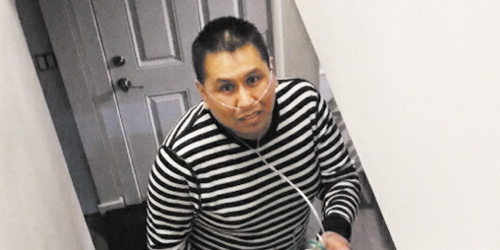
By Shaelyn Hood; photos courtesy of Stephen Morris.
As government-ordered Covid-19 restrictions begin to lift, many people begin to look at what the last two years of living through a pandemic has been like. Though many people had different views and perspectives on issues surrounding the virus, one thing is for sure, the virus was complex. Every person shared a different experience and different symptoms, making it difficult for people to really understand it. Regardless, it doesn’t take away from the real experiences that people went through who had lost their loved ones to the virus, and the people who had to stay in hospitals, fighting for their lives.
Unfortunately, since the start of the pandemic, over 1,300 tribal members contracted the Covid-19 virus. And of those, 10 of them lost their lives. Though active cases continue to go down, it still remains a concern for some people.
One tribal member who recently came out of hospitalization, came forward to share his story about having Covid-19 and the difficult battle he fought. And how getting the virus ended up being a blessing in disguise.
Stephen Morris is a 45 year-old tribal member, who spent most of his life working as a Project Manager for office buildings; supplying and building cubicles and panel systems. After the loss of his wife in 2012, Morris began to struggle with addiction and drugs and started to lose control of his health and well-being.
In early October 2021, Morris began experiencing symptoms of Covid-19, and as they began to progress further, he ended up admitting himself to Providence Hospital in Everett. What started as Covid-19 quickly turned into a bad case of Pneumonia, and his health took a turn for the worse.

Eventually, Morris was intubated, and put into a medically induced coma. Because visitors were not allowed during this time, Morris spent most of his time in the hospital by himself. Often his mother, Rosemarie, would Facetime with the nurses. And even though her son couldn’t hear her, she would talk with him in an attempt to let him know he wasn’t alone.
Morris said “there’s a lot that I don’t remember. And even though I couldn’t hear her, my mom is my hero. She was always there for me and didn’t give up on me.”
It wasn’t until mid-December 2021, after several months on life support, staff began recommending to his family about pulling the plug. It was then that Morris speaks of having a spiritual awakening. While he was in a coma, one of his nieces passed away from an overdose. Not knowing this, he remembers dreaming and speaking with his late-niece, and her insisting it was time for him to wake up. It was then that he finally opened his eyes.
Morris remembers waking covered in wires and tubes, and the surprised faces of the medical staff around him. He felt delirious and exhausted.
Being on intubation is a double edged sword. It is one of the last attempts to save a human life, but can also be very detrimental to someone’s health overall. Those three months took a major toll on Morris’ body, and he now partakes in physical therapy, memory loss therapy, and speech therapy. He moved back in with his mother, and has become more aware of his diet and exercise routine.
One of the biggest transformations that came from this situation, is his newly found sobriety. He knew that gaining control of his sobriety would not only affect his recovery from Covid, but also his recovery in life. He now attends meetings every week, and works in a recovery group. His sobriety has created better relationships within his family, and is helping him build a new support system.
Morris claims to have more inspiration to live his life to the fullest, and to give back more than he ever has before, “I have a second chance at life, and I don’t want to lose sight of it. I’m relearning to do things I used to take advantage of, like walking and talking. I never miss my meetings, and with the help of the tribe, I’m going to go to a school in Everett so that I can be a nurse and I can help other people.”
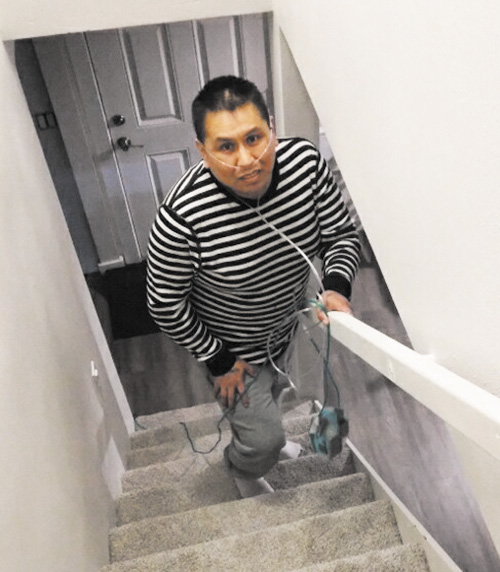
He went on to talk about how this journey has been a major wakeup call and a blessing for him. He plans on giving back by sharing his story more, and speaking about the dangers of addiction and Covid-19.
If you or someone you know that has concerns or questions revolving Covid-19, or are interested in getting the vaccine, please contact Community Health at (360) 716- 5664. If you are struggling with addiction, please contact Behavioral Health at 360-716-4400.
Indigenous Beginnings brings the culture to the people
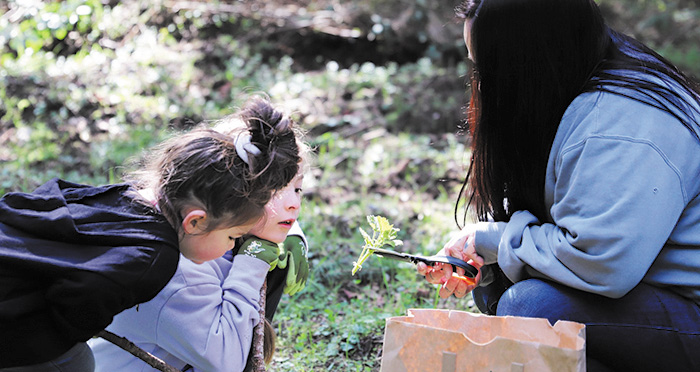
By Kalvin Valdillez, Tulalip News
Across the land, and within each tribe, many Native Americans are fortunate and blessed to grow up surrounded by the culture. Learning the ways of our ancestors who came before us, tribal members are often gifted knowledge at numerous intervals throughout our lives, whether that be our traditional languages, the importance of ceremony, or how to live and thrive of the land, several teachings are passed through the generations. Countless tribal members develop a strong cultural identity at a young age, and that foundation helps keep our way of life alive and is in-turn taught to the future leaders – a beautiful cycle. Which is amazing considering that our traditions were once outlawed with the intention of being completely erased and stripped away during the era of forced assimilation.
However, there is a percentage of Natives who aren’t raised within the culture, especially in today’s modern society. Maybe they grow-up away from their homelands, and only visit their reservations every so often. Or perhaps, with the everyday hustle, their families can’t attend local cultural happenings as often as they would like. And of course, there are those who simply haven’t gravitated to their traditional lifeways just yet. But that doesn’t necessarily mean they do not want to get involved at some point in their lifetime.
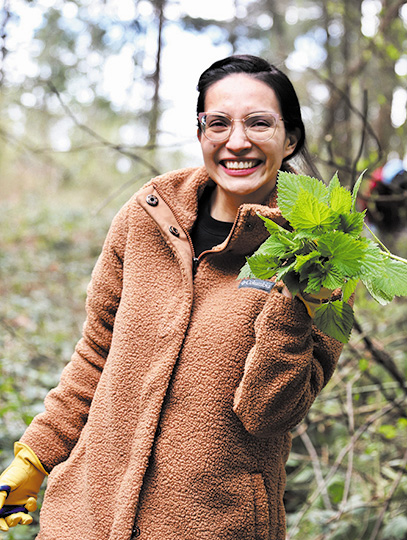
For those individuals who are ready to learn their ancestral teachings, where do they begin? How do they attain that foundation, that base of knowledge to the point where they can practice their traditions with confidence in both a group and personal setting, without feeling awkward, embarrassed or looked-down upon? These are common concerns for urban Natives and others who grew up outside of the culture, especially at large gatherings when you are expected to just jump-in.
The answer comes in the form of a newly established, non-profit organization called Indigenous Beginnings. Founded by Nooksack tribal member and Tulalip community member, Stephanie Cultee, Indigenous Beginnings hosts a variety of cultural workshops and helps tribal members connect to their traditional lifeways.
“Indigenous Beginnings started after COVID happened,” explained Stephanie. “All the programs were kind of shut down, and I thought that it was possible to host a workshop in a safe environment while still practicing our ways. The organization is geared toward passing down the knowledge, so it stays alive and preserving it. There was a whole generation that couldn’t practice or learn their ways from their grandparents because of the boarding school era. And there are a lot of programs that happen at each tribe, but they are all kind of geared towards the youth, and I always felt left out. What about us who aren’t youth? It would always feel weird to attend those events and programs.”
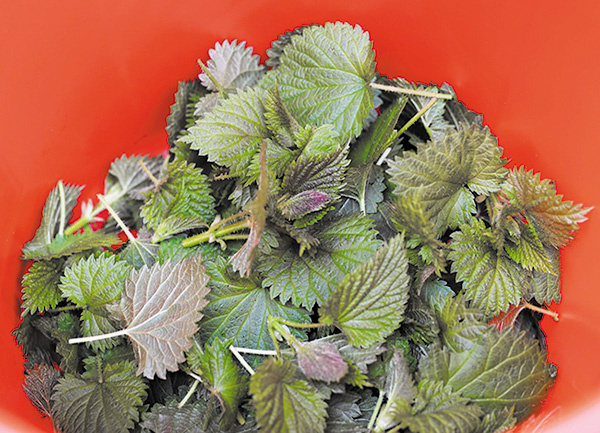
She continued, “With Indigenous Beginnings, all of our workshops are for all ages. For those older generations who want to learn, they could come and don’t have to feel weird about it. I am from Nooksack and moved down here when I was fifteen. I have three daughters who are Tulalip, and I want them to learn their Tulalip heritage and Nooksack’s as well because they are descendants from Nooksack too. I didn’t know much about my tribe, because I moved away when I was young, and I thought this could be a way that I could teach them, and a way that I can learn as well.”
Officially established in the late summer of 2021, the non-profit has already hosted numerous workshops over the past several months. Over ten in fact, and each project is different, so the participants are always learning something new or receiving a fun and interactive refresher. So far, Indigenous Beginnings has hosted harvesting classes, and gathered devil’s club, fireweed and mountain huckleberries, as well as a number of carving classes where participants crafted canoe paddles, fish sticks and cedar earrings. Other classes included a two-part beading seminar, a drum making workshop, and a salmon canning lesson.
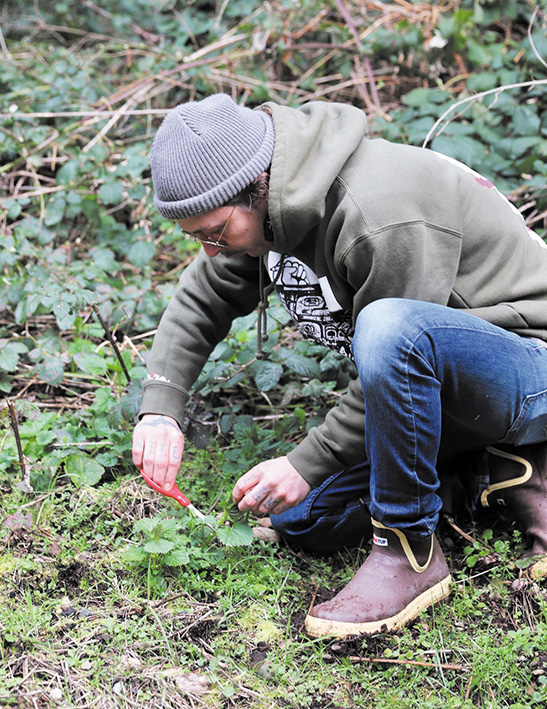
For their most recent gathering, a stinging nettle harvesting workshop, the organization enlisted Tulalip tribal member Thomas Williams to lead the class. On the frosty morning of March 6, approximately a dozen participants met at a clearing in a nearby forest, a local area known as Arcadia.
After teaching the group Lushootseed words for several local Indigenous plants, Thomas shared, “I arrived early in the morning as the birds were still waking and I prayed for the work we are doing today. Before you start harvesting, I ask that you get yourself in a healthy state of mind and let the plant know that you’re a good person and that you come in a good way. That’s part of why I feel that it doesn’t sting me as much, because I have a relationship with this plant and I’m learning how to protect it.
This is our land, and it’s our responsibility to protect it. If we’re coming here and utilizing the medicine, it’s our responsibility to also use our ability to speak and stick up for these resources. We need your help protecting this area so that future generations can continue to come here and utilize that medicine.”
Thomas then demonstrated harvesting techniques while informing the participants what and where to look for when harvesting the stinging nettle plant, indicating that they grow in families and can be seen along the tree lines. Equipped with gloves, buckets and a pair of scissors, the group spent two hours scouring Arcadia for stinging nettles and discussed amongst themselves how they would utilize the plant after the day’s bounty was collected. During this time, the group also shared stories, laughter, prayers and songs, providing each other with the medicine of good company while they worked.
“When you harvest nettles, you talk to them and let them know who you are, who your family is, and that you’re there with good intentions,” said young Tulalip tribal member, Kaiser Moses. “You let them know that you care about the plants, and you care about the environments that the plants exist within. This is important to me because it makes good tea, it’s good in stews and it has good practical benefits, but it also connects me to the environment that I exist in. The forests I drive-by every day, I walk in them and have a connection to them. That plays a big part in my life, because I need the grounding that it provides.”
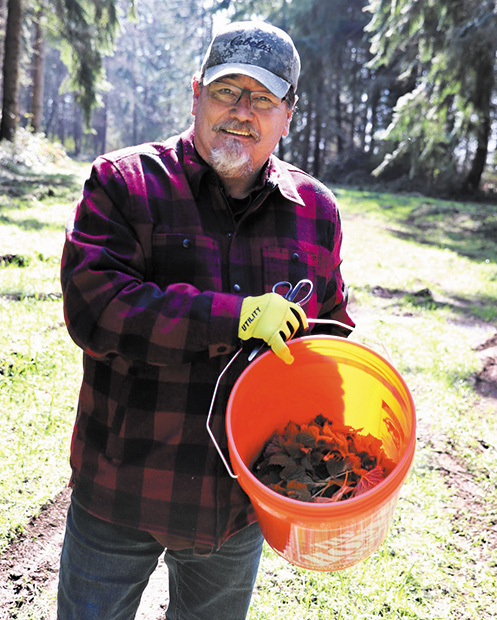
Many participants echoed Kaiser’s sentiment about feeling connected, not only to the culture, but also to the natural world while taking part in the Indigenous Beginnings workshop. Tulalip tribal member Kali Joseph noted that this work is important for our people going forward and continuing to learn and pass on the knowledge of our ancestors.
Said Kali, “It was so cool, and it was super healing. I felt very connected to the land today. It was an honor to be a part of this. It makes me so thankful for Stephanie’s organization because it brings the culture to the people. This was my first-time harvesting stinging nettle. I’m really looking forward to using the medicine further and maybe making a pesto and dehydrating some for a tea. I know that sometimes it’s hard to get connected to your culture when life is so busy, with work and school and other things. So, just to take some time, where everything is set-up for you, where she facilitates it for you, and your instructor teaches you how to harvest and how to use what you harvest further. I think it’s awesome to be a part of.”
She added, “It’s important, the work that we do to sustain and revitalize our culture, because as Native people, we have lots of healing to do and I think that we could utilize this type of work to collectively heal. Indigenous Beginnings is thinking about what’s in the best interest for the next seven generations. Everything we do today has a ripple effect down the next seven generations. And since this my first-time learning, and my little sisters first time learning, we’ll be able to pass those teachings on to many generations down the line.”
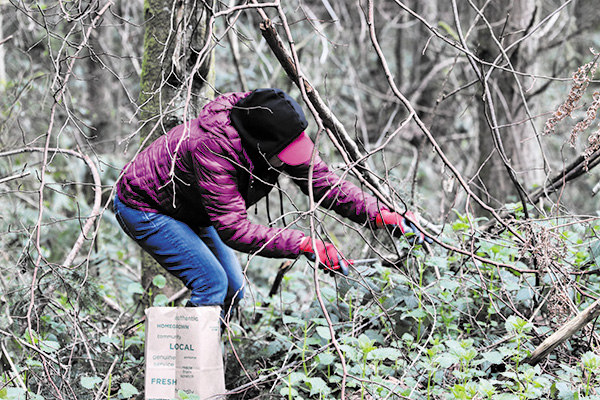
There are many fun and exciting events and classes planned for Indigenous Beginnings that the people can look forward to over the next couple of months as the weather warms up. In addition to more harvesting workshops, rose hips and morel mushrooms are due up next, the non-profit is in the process of coordinating a cedar-pulling workshop, as well as a cedar weaving lesson.
It is Stephanie’s goal to host workshops on different reservations, in addition to both of her homes at Tulalip and Nooksack, and get other local tribes involved in the organization. She also has aspirations of starting a hiking club, where participants can journey, by foot, through their ancestral homelands. Indigenous Beginnings also commissioned a cedar strip canoe from Canadian Native carver Neil Russell, which should be completed before the end of spring. They will teach participants how to pull the canoe out on the open waters.
Stephanie shared, “I want this to be a model, the framework, so other tribal members can form their own branches of Indigenous Beginnings, like Muckleshoot Indigenous Beginnings workshops. Or maybe Alaska, because there’s a lot of Alaskan Natives here in Washington and they could start their own. This is also a great way for our teachers to get funding, to compensate them because they are teaching our traditional ways. It’s mind blowing that there are still people who hold that knowledge, those teachings, and we just want to help pass that knowledge on.”
Indigenous Beginnings is currently looking to add a board member to their team who can advocate for the organization, build connections, assist in fund raising opportunities and attend all of their meetings. If you are interested, or if you would like to find out more about the non-profit, please visit their Facebook page for more information.
